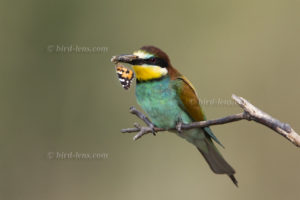 The name already reveals part of the food spectrum of the magnificent birds. Bee-eaters (Merops apiaster) lead a short, eventful life in Germany. The colorful birds only arrive in our latitudes in the second half of May. Bee-eaters feed exclusively on insects, specializing in the hunting of large and medium-sized flying insects. Bees, bumblebees, beetles, wasps, dragonflies and butterflies are among their main prey. In order to hunt them efficiently, the Bee-eater needs a “perch”, an elevated twig, from which it can start hunting. Birds’ habitats therefore always include old trees with bare branches or tall shrubs. In order to avoid stings from its defensive prey, the Bee-eater subjects its victims to a truly murderous treatment. Before devouring them, he kills non-toxic insects by knocking them on a branch several times. Or he occasionally throws them in the air and catches them again. European Bee-eaters always grab “poison-biting” insects on the abdomen and hits them once or twice on a branch before rubbing the end of their abdomen on a branch. This is how the poison is drawn out of bees or wasps and is removed thereafter. After a few more hits on the head, the insect is finally ready to eat. Who likes to risk a stab in the esophagus?
The name already reveals part of the food spectrum of the magnificent birds. Bee-eaters (Merops apiaster) lead a short, eventful life in Germany. The colorful birds only arrive in our latitudes in the second half of May. Bee-eaters feed exclusively on insects, specializing in the hunting of large and medium-sized flying insects. Bees, bumblebees, beetles, wasps, dragonflies and butterflies are among their main prey. In order to hunt them efficiently, the Bee-eater needs a “perch”, an elevated twig, from which it can start hunting. Birds’ habitats therefore always include old trees with bare branches or tall shrubs. In order to avoid stings from its defensive prey, the Bee-eater subjects its victims to a truly murderous treatment. Before devouring them, he kills non-toxic insects by knocking them on a branch several times. Or he occasionally throws them in the air and catches them again. European Bee-eaters always grab “poison-biting” insects on the abdomen and hits them once or twice on a branch before rubbing the end of their abdomen on a branch. This is how the poison is drawn out of bees or wasps and is removed thereafter. After a few more hits on the head, the insect is finally ready to eat. Who likes to risk a stab in the esophagus?
Because of its food spectrum, the bee-eater relies on a warm climate. Over the centuries European Bee-eaters has continued to expand its distribution area to the north. But it is an eventful story of expansion and withdrawal. The Bee-eater is currently on the rise again. Breeding pairs have even been observed in Denmark. In Baden-Württemberg, the area around the sunny Kaiserstuhl with its loess soils offers the best conditions. Around 100 pairs breed on the Upper Rhine today.
The fact that Bee-eaters use a habitat almost on my doorstep now has enabled me to visualize their entire annual life. From the arrival in early May until the young birds flew out at the end of July, it was possible to photograph the way these remarkable birds live. The advantage is that the Bee-eater is basically not very suspicious. The camouflage tent does not have to be placed weeks in advance. Stopping the tent is also not necessary. However, it is beneficial to find a breeding wall that is not in the immediate vicinity of trees or exposed sticks, and instead to place tempting branches near the breeding walls.
Experience has shown that these temporary perches are all occupied quite quickly, and there are often quarrels among these birds about the best places. So you can nicely photograph some of these arguments. It is convenient to choose your own location so that you get a good view of the mud wall on the one hand and the photo branches on the other. There were always several breeding pairs present anyway. This hardly resulted in a recovery phase for my finger, which was tired from being moving the shutter release. I was so fascinated by the constant activity of the Bee-eaters that I never thought of taking a break. I was constantly watching how they either dig, maintain the plumage, or bring in food. Activities continued from May until the birds departed in August. Due to their way of life, the remarkable cooperation and their tirelessness of the parents, it is a real pleasure to photograph the colorful Bee-eaters.
In order to meet the growing demand for top images of the rarer species of Palaearctic Bird-lens.com has specifically made trips to remote places. Additionally every chance is used, if a rare bird is around the homeground. This to do everything to ensure excellent photos of the Birds of the Western Palearctic . The yield of pictures also of rare Western Palaearctic birds is very good, as you can see with the picture of the blog. Other nice images of birds you will find behind the tab “Picture Shop“. Just give a notice if you need a picture of a bird which is not online.